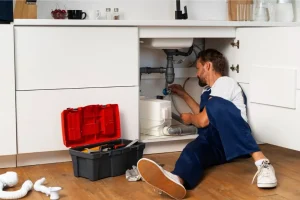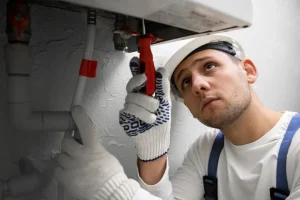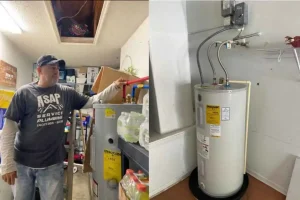It is frustrating when your electric water heater fails to provide hot water. If your electric water heater isn’t heating, it could be due to a range of simple or more serious issues.
The reasons can be a degradation in power supply, a malfunctioning thermostat, defective heating elements, sediment buildup, and more. Whatever the reason, your water heater needs a thorough inspection to get it working again.
Let’s learn why your electric water heater isn’t heating and how to restore its functionality.
Possible Reasons and Fixes For Electric Water Heater Not Heating Water
Before getting details, check the table below, highlighting all the probable reasons for your electric water heater’s no hot water issues with instant fixing ideas:
| Potential Reasons | How You Fix It |
| Faulty power supply | Reset the tripped circuit breaker. Replace the blown fuse or faulty wiring system. |
| Malfunctioning thermostat | Inspect your electric water heater thermostat setting to see whether it is adjusted correctly. Replace the faulty thermostat. |
| Hard water mineral buildup | Flush your water heater |
| Bad heating elements | Replace the bad heating elements. |
Major Reasons For Why Your Electric Water Heater Not Working?
Is your electric water heater not heating up? Here are the common reasons we often notice.
1. Degradation In Power Supply
A steady power supply is crucial for an electric water heater. Any fluctuation or degradation in the power supply can prevent the heater from functioning correctly.
Inconsistent voltage can cause the heater to fail intermittently or not work at all. This issue can arise from faulty wiring, a tripped circuit breaker, or problems with the main power source.
2. Malfunctioning Thermostat
The thermostat in your water heater regulates the water temperature. If the thermostat malfunctions, it can not send the correct signals to the heating elements.
It can result in water being too cold or too hot. A malfunctioning thermostat gives inaccurate temperature readings that will cause inconsistent heating performance.
3. Defective Heating Element
The heating element is essential for warming the water. If it becomes defective, the water heater will struggle to heat the water or fail.
Heating elements can wear out over time or burn out due to electrical issues. When this happens, the heater can’t generate the necessary heat to warm the water.
4. Sediment Buildup
Over time, minerals in the water can accumulate at the bottom of the tank, which leads to sediment buildup. It acts as an insulating layer between the water and the heating elements.
As the sediment layer thickens, the heating efficiency decreases, making it harder for the heater to maintain the desired water temperature. Sediment buildup can also cause strange noises and reduce the heater’s lifespan.
How To Troubleshoot An Electric Water Heater Not Heating?
Here are DIY steps to troubleshoot you can apply to resolve the issue.
1. Fix The Power Supply Issue
Ensure the water heater is receiving adequate power. Check the circuit breaker or fuse box linked to the heater. If a breaker has tripped or a fuse has blown, reset or replace it.
Inspect the wiring connected to the heater for any signs of damage or wear. Use a multimeter to check the voltage going to the heater. If the voltage is too low, contact an electrician to fix the problem.
2. Flush Out Your Water Heater
Sediment buildup inside the water heater tank can interfere with heating performance. First, switch off the power at the circuit breaker and turn off the water supply valve.
Connect a garden hose to the drain valve at the bottom of the tank. Place the other end in a floor drain or outside. Open the valve to let the water flow and clear out any sediment.
Close the drain valve once the water runs clear. Turn on the water supply valve and allow the tank to refill. Finally, restore power to the heater.
3. Inspect The Thermostat Setting
Check the thermostat settings to ensure they are correctly adjusted. Locate the thermostat panel on the heater, typically found behind an access panel.
Verify that the temperature setting is appropriate for your needs. If the thermostat is programmable, ensure it is programmed correctly according to your usage patterns.
Test the thermostat by adjusting the temperature settings and monitoring the heater’s response. If you suspect the thermostat is malfunctioning, consider replacing it with a new one compatible with your water heater model.
4. Replace The Bad Heating Elements
If the heating elements are faulty, they need replacement to restore heating functionality. To do it, turn off the water heater’s power at the circuit breaker and close the water supply valve.
Drain the water heater tank completely by connecting a garden hose to the drain valve and opening it.
Once drained, locate the access panels on the heater, typically found near the top and bottom of the tank. Remove the panels and any insulation covering the heating elements.
Use a multimeter to check the continuity of each heating element. If a component shows no continuity, it is defective and requires replacement.
If They Don’t Work, Reach Out To a Plumbing Expert
If troubleshooting the water heater doesn’t work, it’s time to call a professional. In Orlando or Kissimmee, ASAP Service Plumbing assists in diagnosing and repairing electric water heaters. We have the expertise and experience to tackle complex issues safely and efficiently.
Professional plumbers in our team conduct thorough inspections of your electric water heater parts to identify the root cause of the problem and execute appropriate solutions.
Whether it’s fixing faulty wiring, replacing broken parts, or doing maintenance, we ensure the water heater runs efficiently.
Our Maintenance Tips To Prevent ‘No Hot Water’ Issues in Electric Water Heater
Regular maintenance is key to ensuring your electric water heater operates smoothly. Here are some tips:
- Drain and flush the tank once a year to remove sediment buildup.
- Test the pressure relief valve annually to ensure it functions properly and prevents excessive pressure buildup.
- Check your electric water heater anode rod every few years for corrosion and replace it if necessary to prevent tank corrosion.
- Ensure the thermostat is set to the appropriate temperature and consider lowering it to save energy.
- Periodically check the heating elements for signs of corrosion or damage and replace them as needed.
In Closing
A malfunctioning electric water heater that isn’t working can disrupt daily routines. However, finding out the root causes can restore its functionality. Through troubleshooting issues like power supply degradation, thermostat malfunctions, defective heating elements, and sediment buildup, you can resolve many problems.
Regular maintenance can also prevent future issues. However, if these steps don’t work, call us in Orlando or Kissimmee for diagnosis and repair services and ensure your water heater operates efficiently.
Frequently Asked Questions
How can I tell if my thermostat is faulty?
Signs of a faulty thermostat include inconsistent water temperatures or water that is too hot or too cold. Testing with a multimeter can confirm issues.
How often should I inspect and maintain my electric water heater?
Regular maintenance should be performed annually, including checking the pressure relief valve, flushing the tank, and inspecting the anode rod and heating elements.
How do I reset my electric water heater?
To reset, locate your electric water heater reset button on the thermostat, usually behind an access panel. Press the button to reset the heater.
What temperature should my water heater be set to?
A recommended setting is around 120 degrees Fahrenheit to ensure efficient heating while preventing scalding and reducing energy consumption.




